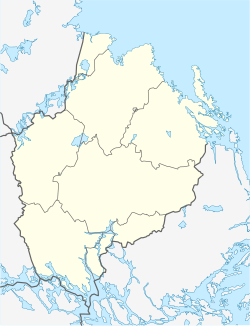Ultuna
Appearance
Ultuna | |
|---|---|
 A building of the Swedish University of Agricultural Sciences, January 2013. | |
| Coordinates: 59°49′00″N 17°39′30″E / 59.81667°N 17.65833°E | |
| Country | Sweden |
| Province | Uppland |
| County | Uppsala County |
| Municipality | Uppsala Municipality |
| Area | |
| • Total | 1.2 km2 (0.5 sq mi) |
| Population (31 December 2020)[2] | |
| • Total | 2,062 |
| • Density | 1,700/km2 (4,500/sq mi) |
| Time zone | UTC+1 (CET) |
| • Summer (DST) | UTC+2 (CEST) |
| Locality code | T0654 |
Ultuna (Swedish pronunciation: [ˈɵ̂lːˌtʉːna])[3] is a locality in Uppsala Municipality, Uppsala County, Sweden with 449 inhabitants in 2017.[1] Located 5 kilometres (3 mi) south of central Uppsala, it hosts the headquarters and main campus of the Swedish University of Agricultural Sciences (Sveriges lantbruksuniversitet, SLU).
Ultuna is known for sharing (with Målilla, Småland) Sweden's heat record of 38.0 °C (100.4 °F), which was recorded on 9 July 1933.[4]
The name
[edit]The name, originally the name of an estate, is first recorded in 1221 ("in villa Wlertune"). The first element is the genitive case of the name of the Norse god Ullr. The last element is tuna 'enclosed field'.[5]
References
[edit]- ^ a b "Localities 2017 – population, area, overlap holiday home areas, coordinates" (XLSX). Statistics Sweden. 28 March 2018. Retrieved 12 November 2018.
- ^ "Statistiska tätorter 2020, befolkning, landareal, befolkningstäthet". Statistics Sweden. 31 December 2020. Retrieved 3 June 2024.
- ^ Jöran Sahlgren; Gösta Bergman (1979). Svenska ortnamn med uttalsuppgifter (in Swedish). p. 26.
- ^ "Svenska temperaturrekord" (in Swedish). Swedish Meteorological and Hydrological Institute. Retrieved 24 February 2018.
- ^ Wahlberg, Mats, ed. (2003). Svenskt ortnamnslexikon (PDF) (in Swedish) (1st ed.). Uppsala: Swedish Institute for Dialectology, Onomastics and Folklore Research. p. 336. ISBN 91-7229-020-X. SELIBR 8998039. Retrieved 24 February 2018.


